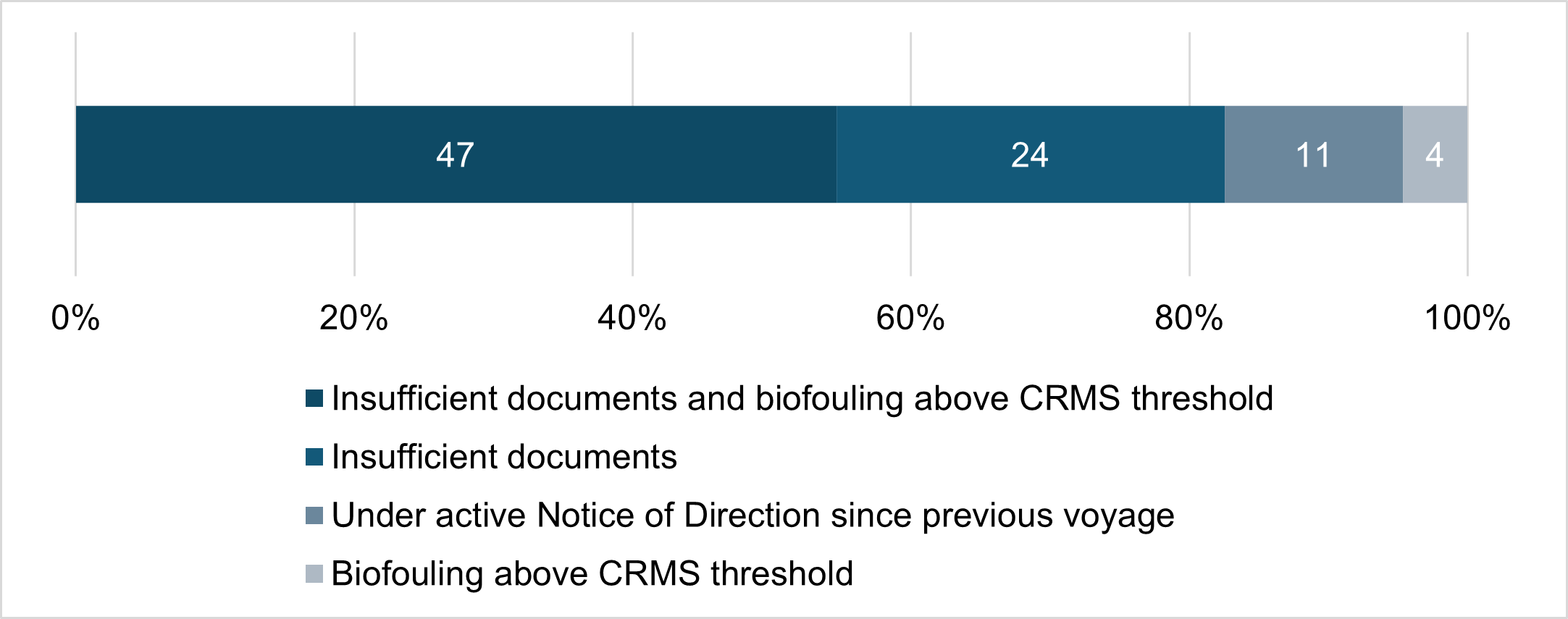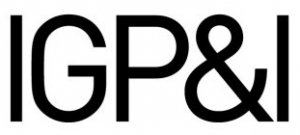On 1 May 2025 submission of a Biosecurity Pre-Arrival Report (PAR) prior to arrival in New Zealand became mandatory. Certain vessels arriving in the country may also be required to go through a biofouling assessment, the failure of which can lead to disputes between owners and charterers.

Fouling up Down Under: Biofouling non-compliance in New Zealand
Published 12 June 2025
New Zealand's inaugural 2025 issue of the Vessel Biosecurity Quarterly highlights data for the 2024 calendar year on vessel biofouling assessment failures and the issuance of Notices of Direction as part of the compliance actions taken.
Biofouling assessments in New Zealand
As most owners, managers, and charterers will know, the updated Craft Risk Management Standard (CRMS) for Vessels, effective from October 13, 2023, now includes all biosecurity regulations for vessel topsides and biofouling, integrating the former Craft Risk Management Standard for Biofouling (2018) and the Craft Risk Management Standard for Vessels (2018). To assist vessels arriving in New Zealand, the Ministry for Primary Industries has provided a poster and an FAQ document.
Vessels may be required to undergo a Biofouling Assessment for reasons such as:
vessel’s first arrival to New Zealand;
time elapsed since last assessment;
increase in risk level, e.g. long lay-ups since previous assessment;
vessel’s intentions in New Zealand changing (“long stay” voyage);
receipt of new documents;
vessels returning with active Notice of Direction (NOD), or previous assessment failures, are reassessed on return.
A failed assessment does not automatically bar a vessel from entering New Zealand. Biosecurity NZ tailors its response to the specific biofouling risk posed by each vessel. As per Ministry of Primary Industries (MPI), compliance actions taken against these vessels are proportionate to the level of risk the vessel presents. For example:
lower risk vessels may be allowed to complete their declared itinerary and required to manage their biofouling before their next voyage.
high risk vessels may be directed to leave New Zealand within 24 hours.
in circumstances where the risk is unclear, a vessel may be directed to undertake a hull inspection.
Changes to biosecurity requirements
The Biosecurity Pre-Arrival Report (PAR) became mandatory with effect from 1 May 2025, superseding previous documentation. Introduced voluntarily on 31 October 2024, the PAR replaces the Master’s Declaration and the Biofouling and Ballast Water Declaration. Vessels must submit the PAR to MPI at least 48 hours before entering New Zealand Territorial Waters. The submission process remains unchanged, and the Advance Notice of Arrival (ANOA) is still required.
It is worth highlighting the minimum evidence requirements for vessel biofouling inspections that came into force on 13 April 2025. The requirements were introduced as part of the revised Craft Risk Management Standard (CRMS) for Vessels, released in October 2023, with an 18-month lead in period. The requirements include the need for vessel operators to ensure that any contracted dive providers supply evidence that complies with the requirements. Key areas to focus on, based on recent assessments, include:
Images and videos must be correctly labelled and timestamped, or the image properties must contain this information,
Images and video are to be of high quality (i.e. a level that allows the viewer to identify biofouling to a broad taxonomic group, e.g. barnacles, tubeworms),
Three images and one video must be collected for each location listed in Schedule 3. Not all of these need to be incorporated into the PDF report, however, they must be available upon request,
Areas unable to be accessed or surveyed must be specifically identified in writing on the PDF report along with the reasons.
Biosecurity NZ’s 2024 vessel assessment findings
86 vessels failed the Biofouling Assessment last year, of which nearly 55% were due to “insufficient documentation and biofouling above the Craft Risk Management Standard (CRMS) threshold”, as shown in the graph below.

Reasons for Biofouling Assessment Failures, 1 January – 31 December 2024
The number of Notices of Direction (NODs) issued in 2024 shows a decrease compared to 2023, from 119 to 86. Consequently, all these vessels received a NOD, outlining the necessary steps to manage their biofouling risk; for instance, 10 of these vessels had their itinerary limited to under 24 hours.
Among the types of vessels failing inspections, general cargo ships showed the highest percentage of failures relative to their arrival numbers, followed by passenger ships.

% failed compared to total arrivals per ship type
Commercial implications of failing a biofouling assessment
Case study 1
To meet New Zealand's biofouling rules before arrival, a vessel had an underwater inspection and cleaning (UWI/C) in a port in West Africa. The report was sent to NZ MPI for short-stay approval. MPI found it didn't meet CRMS standards due to insufficient proof of sea chest cleaning, so a Notice of Direction was issued, requiring verifiable hull and niche area cleaning proof within 24 hours of entering New Zealand waters. Owners had to arrange cleaning and inspection of the sea chest area before arrival in New Zealand to lift the NOD, causing a cost and time dispute with the charterer.
Case study 2
The vessel was on a short period time charter and performing the first voyage from Malaysia to New Plymouth in New Zealand. The vessel was rejected by NZ authorities due to failing to comply with the biofouling regulations. Owners deviated the vessel to Bundaberg, Australia for hull cleaning to meet the biofouling requirement. Due to bad weather, the vessel only completed the cleaning and departed Bundaberg and reached New Zealand 3 weeks later than scheduled, thereby missing the laycan. Charterers had to arrange for an alternate business. The intention of calling NZ as first voyage was also made known to owners during fixing.
Liabilities arising from biofouling issues in both case studies hinge significantly on the express inclusion or omission of biofouling clauses within the charterparty agreement. Without explicit provisions, resolving disputes becomes far more complex, often leading to protracted disagreements between owners and charterers. We discuss the legal aspects in greater detail below.
Legal implications
a Express clauses dealing with biofouling
Where the charterparty contains express clauses dealing with biofouling, the position is often clear-cut and would largely be favourable to charterers.
Examples of such clauses include:
| Owners’ warranties |
|---|
| ‘Owners confirm that ... Vessel is fully compliant and in conformity with all regulations and requirements for trading to New Zealand’ |
| The New Zealand Biofouling Clause |
|---|
| ‘Owners acknowledge they are familiar with biofouling rules and requirements currently in force and/or due to be enforced in the territory of New Zealand. Owners further warrant that the vessel will not pose a biofouling risk and that at all times she will be fit in all respects including hull condition for calling in New Zealand waters in accordance with said rules and requirements. |
| In the event that the vessel is denied entry, required to comply with directions, orders or requests of the New Zealand authorities, detained or rejected from New Zealand’s territorial waters the vessel shall be immediately off hire from the commencement of any loss of time until she is again ready and in an efficient state to resume her services from a position not less favourable to Charterers than that at which such loss of time commenced. Owners will be responsible for the use of fuel during any off-hire period. Owners will be responsible for any claim, loss, damage (including delay) or expenses of whatsoever nature resulting from a breach of this clause including without limitation losses that Charterers may incur in relation to any party to which they have contracted with and have been unable to perform including delayed performance.’ |
| Clauses dealing with hull cleaning prior to reaching New Zealand |
|---|
| ‘Owners will arrange underwater cleaning of vessel’s hull, propeller and niche areas at XX and cost of time and same to be shared 50/50 between Owners and Charterers.’ |
The New Zealand Biofouling Clause is a very comprehensive clause in charterers’ favour dealing with loss of time, costs of hull cleaning and any follow-on losses including potentially the loss of the original fixture as in the second case study.
b. No express clauses dealing with biofouling
Where the charterparty does not have express clauses dealing with biofouling, the position is less certain.
Charterers may wish to argue that owners’ obligation to ensure that the vessel is in good order and condition and in every way fitted for the service and also their obligation to maintain the fitness of the vessel extend to ensuring that the vessel satisfy the arguably stringent New Zealand biofouling regulations.
This would be a plausible argument assuming New Zealand is within the trading limits of the charterparty, and commercial fitness requires that the vessel be capable of trading to New Zealand ports without undue delay imposed by the need to make the Vessel compliant with the applicable regulations.
On the other hand, it is also arguable that if the vessel’s hull is clean by ordinary standards and/or is not fouled in a way which affects the ordinary performance of the vessel, then fitness does not require satisfaction of the abnormally stringent requirements of one specific country within the trading limits.
Unfortunately, there is presently no clear authority on the point and it is expected that commercial arbitrators hearing evidence on each specific case could take very different views.
Owners may also wish to rely on any express or implied indemnity to pass on any expenses incurred in hull-cleaning to charterers on the basis that they were carrying out charterers’ employment orders. Whether or not hull cleaning costs are within the scope of such an indemnity will depend on whether the costs can be considered ordinary expenses incurred in the trading of the ship. If so, owners will be deemed to have agreed to bear such costs. If not, then these costs are normally for charterers.
If the hull cleaning requirements imposed by New Zealand regulations are materially more stringent than those that generally apply, then this could be a factor in owners’ favour. Other factors may also come into play including whether the parties contemplated these regulations when they entered into the charterparty.
Both owners and charterers are encouraged to spell out in express terms in the charterparty which party is to bear liability for the vessel not meeting the biofouling regulations and also how the time loss, costs of any hull cleaning, and additional losses are to be borne.
Recommendations
In order to avoid undue risk of delay and incurring additional costs of hull cleaning when calling at New Zealand ports, Members and clients trading in this region are advised to:
Familiarise themselves with the revised Craft Risk Management Standard (CRMS) and the reporting requirements.
Actively manage and minimise biofouling before arrival. Masters and operators must also ensure they have up-to-date vessel maintenance records or verifiable evidence that the hull has been cleaned. Owners and operators can contact MPI (standards@mpi.govt.nz) for guidance on acceptable hull preparation, cleaning, treatment, and inspection.
Review their charterparties to clearly establish which party assumes the risk for delays and losses arising from anti-bio fouling enforcement actions taken against the vessel.
Further reading
Gard articles
Ministry for Primary Industries in New Zealand:
IMO
The IMO’s Biofouling page provides useful information, including an overview of its efforts to build a legally binding framework for the control and management of ship biofouling, as well as links to current guidelines such as the:
Recently approved Guidance on in-water cleaning of ships' biofouling


